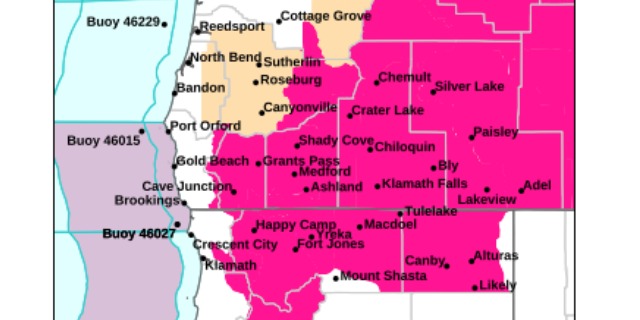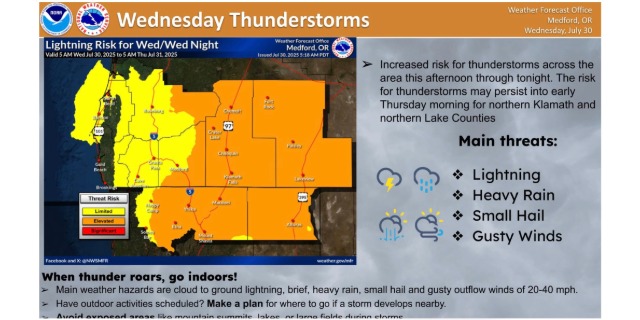‘First Descent’ underway: Kayakers following undammed river to Pacific Ocean
Published 9:12 am Saturday, June 14, 2025


Thirty-day paddle event will take participants along Wood, Klamath rivers to the Northern California coast
The “First Descent,” a 30-day paddle from the Wood River along the Klamath River to the Pacific Ocean near Requa, California, began Thursday.
The kayak trip will feature young members of tribes that live along and are influenced by the Klamath River. The Klamath officially begins near Klamath Falls but has sources upstream, including the Wood, Williamson and other rivers. The trip will celebrate the removal of four dams — John C. Boyle, Copco 1 and 2, and Irongate — but the paddlers will portage around the remaining Link River and Keno dams.
Trending
The journey, officially a Paddle Tribal Waters adventure, has drawn regional, national and even international interest. John Enders, who is handling public affairs, said the news organizations sending reporters or planning to do reports after the trip’s scheduled July 11 conclusion include the New York Times, Washington Post, San Francisco Chronicle, Eureka Times-Standard, Oregon Public Broadcasting and Jefferson Public Radio, Libértad Newspaper from Paris, Reuters and “probably some I don’t even know about.”
Enders said there also will be kayak club members from Chile, Bolivia, and Peru, and people from New Zealand and China.
“The Paddle Tribal waters program is a vital part of preserving the Klamath people’s cultural heritage and connection to their ancestral lands,” said Ashia Wilson, a representative of the Klamath Tribes who has been involved in the First Descent. “By revitalizing traditional paddling practices, we’re not only honoring our history but also empowering future generations to carry on our stories, songs, and ways of life. This program strengthens our community’s resilience and fosters a deeper understanding of our place in the natural world.”
Nearly 30 tribal youth who have participated and graduated from kayak training sessions will attempt to go the distance that, including the Wood River and crossing of Upper Klamath Lake, is about 280 miles. Depending on individual skill levels, some may portage around some of the Klamath’s especially challenging rapids.
Among the kayakers will be Coley Kakols Miller, 14, who said, “I am excited to kayak again with my PTW family and represent the Klamath Tribes on the First Descent with my cousins. I was raised as a river kid, and I love where I come from. Since I was little, I drank ambo (Klamath word meaning water) from the spring where the Klamath River starts. And now I get to kayak from where I drink, following the water on the almost free Klamath River to the ocean.”
Coley’s mother, Natalie Ball, a Klamath Tribes member, offered praise for the program, stating, “Through Paddle Tribal Waters, our tribal kids have a deeper connection with the Klamath River and its waterways, with our fish relatives, particularly our endangered koptu and c’waam, with the challenges that our tribes continue to face, and now they are connected with one another. Our kids now carry a powerful intertribal connection that has united our communities and families. Their profound connection and understanding of self and love for their homelands will lead us forward as we continue to care for and protect our homelands, cultures, and communities.”
Trending
Coley was part of the Paddle Tribal Waters program that organized a series of training sessions over the past three years that, according to PTW, “taught youth the skills required to safely run the river in a kayak, a link to the historical use of dug-out canoes by Indigenous people of the Klamath Basin.”
The nonprofit organization partnered with the World Class Kayak Academy and taught the teens all aspects of whitewater boating, including how to identify risks and maneuver through large rapids. The group also learned self-rescue techniques, how to read the water and more.
Along with skill-building training, the youth also worked to develop river advocacy skills. Two local youth kayak clubs, Maqlaqs Paddle and Páah Áama, were formed by alumni of the programs with the goal of “providing opportunities for youth in the Klamath Basin for years to come,” PTW states.
Enders said the plan calls for kayakers to begin at a leisurely pace, especially in the first few days, followed by a series of layovers and celebrations by the Hoopa, Yurok and other Klamath River tribes. Once the trip begins, organizers plan to have limited public contact with a goal of allowing the kayak team to appreciate the river atmosphere.
Things will change once the group nears the Pacific. “Big Show” is planned when the kayakers reach the Pacific Ocean on Friday, July 11, at the mouth of the Klamath River at Requa. Along with a welcoming program, a series of events are scheduled Saturday and Sunday, July 12-13, in Klamath, California.
The month-long descent will culminate with a flotilla of tribal leaders, family members, and river activists from around the world meeting the young kayakers as they reach the mouth of the river at Requa, California. It’s expected the paddlers will be joined by families, friends and others along the lower Klamath for the final day or days. At Requa, an arrival dinner reception will be held for students, families, and supporters of the dam removal efforts, featuring artwork that celebrates the dam-free river and ongoing river conservation efforts.
The celebration will continue from noon to 8 p.m. Saturday, July 12, when people from the entire river region will gather in Klamath, California for a festival featuring live music, art exhibitions and auction, local cuisine, and a community gathering. The festivities will culminate with a special evening surprise performance. The event will be open to the public, but tickets must be purchased in advance. To sign up and receive updates, visit www.riostorivers.org/klamath-dam-removal-celebration.
Closing out the activities will be a Free Rivers Symposium on Sunday, July 13, that will include tribal leaders, environmental organizations, and scientists to highlight the ecological and cultural significance of the restored river. The symposium, organizers said, will “explore the long-awaited return of Chinook salmon to their ancestral spawning grounds, the far-reaching benefits of dam removal, and the revival of an entire ecosystem. Experts will share insights on water quality improvements, habitat restoration, and the lasting impacts on wildlife and river communities.”
It will culminate with the signing of the Klamath River Accord that, according to PTW, will mark “a new era of stewardship and resilience.”
Email freelance writer Lee Juillerat at 337lee337@charter.net. This story first appeared at Ashland.news.










